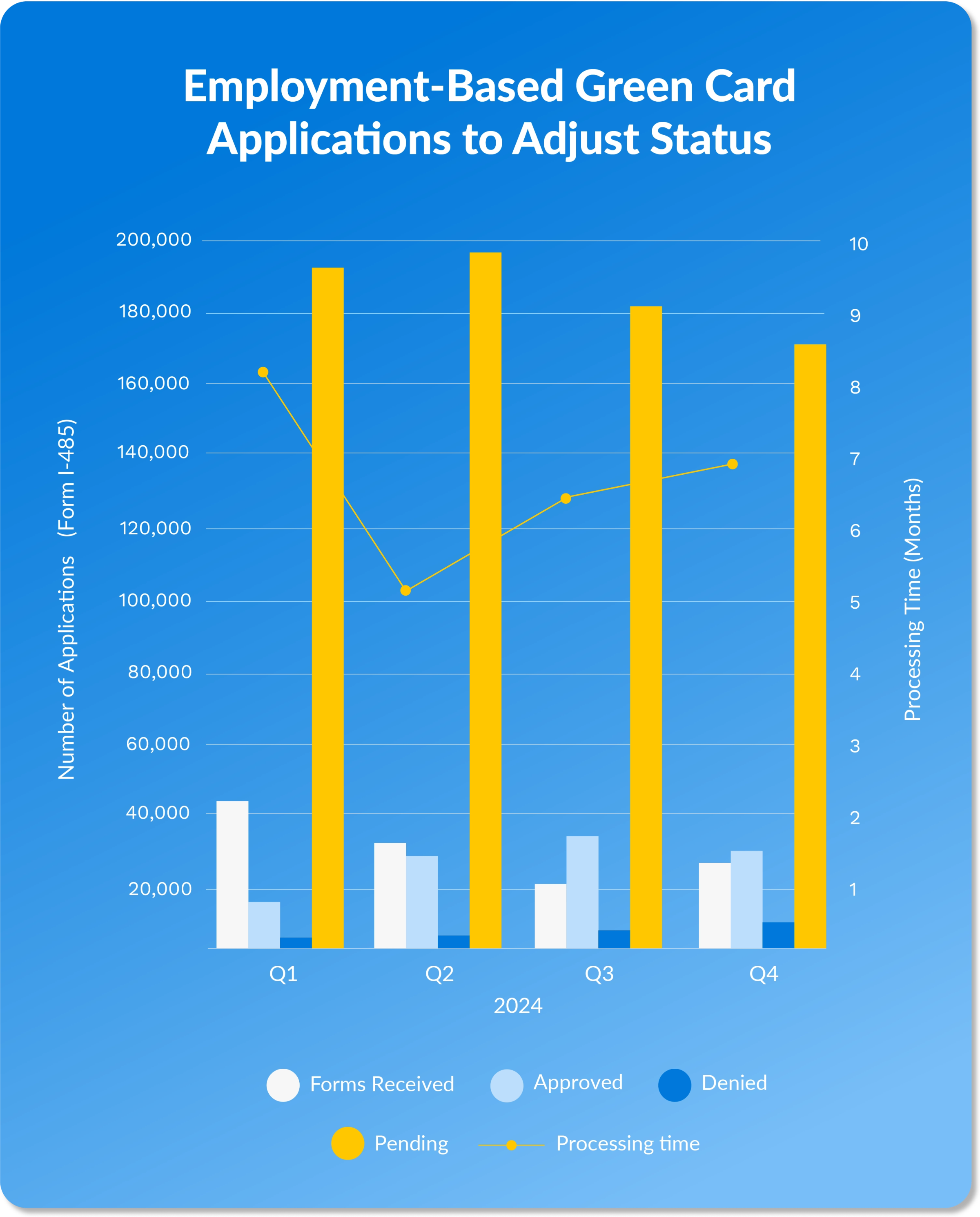Today, more than 14 million people in the U.S. hold green cards, and every year, hundreds of thousands more begin that journey through family sponsorship, employment, or the green card lottery. In 2024 alone, over 129,000 employment-based green card applications were filed, according to the latest data from USCIS.
For immigration lawyers, these figures aren't just statistics—they’re signposts. Understanding the trends behind green card approvals, denials, processing times, and country caps helps you guide clients with clarity and confidence.
This article unpacks the most recent green card statistics and offers practical insights you can use to shape case strategy, manage expectations, and grow your practice with purpose.
How Many Green Cards Are Issued per Year?
The number of issued green cards and pending green card applications by year fluctuates. In recent years, annual green card issuance has bounced back to pre-pandemic levels. In fiscal years (FY) 2023 and 2024, the U.S. issued just over 1 million green cards covering family-based, employment-based, humanitarian, and diversity lottery categories.
Each of these categories serves a distinct purpose in the immigration system, and understanding how they differ is essential for advising clients effectively. Below, we’ll explore the most common types, including how many were issued, approval trends, and what that means for your practice.
Employment-Based Green Cards
Employment-based green cards often hinge on strict eligibility requirements—including job offer validation, labor certification, and maintenance of lawful status—so approval is heavily dependent on documentation quality and regulatory compliance.
Here’s a closer look at employment green card statistics in FY 2024:
129,814 applications filed (form I-485, employment-based)
119,028 approvals (91%)
13,485 denials (9%)
Average green card processing time: 6.7 months
While the approval rate remained high, several notable shifts occurred throughout the year. For example, processing times varied quite a bit—according to USCIS, the average processing time for employment-based green card applications between October 2023 and Sepetmber 2024 was 13.2 months, ranging from as low as 10.7 months in January 2024 to 25.3 months in September 2024. This wide range reflects fluctuations in workload, staffing, and procedural backlogs.
One key factor driving these fluctuations is the intermittent release of visa numbers, which often causes surges in filings and slowdowns in adjudication. Additionally, some service centers experience heavier caseloads than others, contributing to inconsistent processing times.
In terms of the 13,485 denials in FY 2024, these numbers reflect an important reality: Not all employment-based filings are equal. Common root causes of denial include:
Inadmissibility findings (e.g., prior immigration violations or criminal records)
Failure to maintain lawful nonimmigrant status
Insufficient supporting documentation
Employer or job-based eligibility issues
These patterns highlight the importance of early-stage screening, detailed evidence gathering, and monitoring shifts in adjudication policy. For immigration attorneys, being aware of these trends is key to minimizing risk and setting accurate expectations with clients.
Family-Based Green Card
Family-based green cards allow U.S. citizens and lawful permanent residents to sponsor close relatives—such as spouses, parents, children, and siblings—for permanent residency. This pathway remains a cornerstone of the U.S. immigration system, offering reunification opportunities for millions of families. Immediate relatives (spouses, unmarried children under 21, and parents of U.S. citizens) typically experience shorter wait times because they are not subject to annual visa caps. In contrast, siblings and adult children fall into family preference categories, which face annual limits and often result in much longer wait times, especially for applicants from high-demand countries.
In FY 2024, family-sponsored green card applications far outpaced employment-based filings, both in volume and in approvals. Here's a closer look at the data:
473,464 I-485 applications filed
412,475 approved 47,496 denied
Average processing time: 9 months across the year
Over 500,000 cases pending each quarter
Each quarter of FY 2024 saw consistently high filing volumes, with application numbers exceeding 110,000 per quarter and peaking in Q3 at 124,926 applications. Approvals also reached their highest in Q3 at 113,472, reflecting USCIS efforts to work through significant backlogs.
Encouragingly, processing times for family-based green cards steadily improved throughout the year:
Q2: 10.1 months
Q3: 8.8 months
Q4: 7.7 months
This trend suggests that efficiency measures or increased staffing may be starting to ease congestion. That said, denial rates remained substantial, with nearly 50,000 denials recorded for the year, underscoring the importance of complete documentation, eligibility screening, and accurate petition filings.
Additionally, despite improvements in processing speed, the pending caseload remained consistently above 500,000 throughout the year. This reflects the intense and sustained demand for family-based immigration and the structural bottlenecks still present in the system.

Family-Based Green Cards Issued by Country
The Immigration and Nationality Act (INA) sets a per-country limit that caps the number of green cards issued to nationals of any single country at 7% of the total annual green cards available worldwide. This means that no matter how many applicants come from a particular country, only 7% of the total family-based and employment-based green cards issued each fiscal year can be allocated to that country. These per-country limits impact processing timelines, especially in family-based categories where demand is highest.
Understanding this breakdown is essential for immigration attorneys advising clients on expected timelines and strategic filing decisions.
Here are the top 10 countries that received the most family-based green cards in FY 2024, according to the Department of Homeland Security:
Mexico: 161,705
Dominican Republic: 45,270
Philippines: 40,678
Cuba: 33,539
India: 29,725
Vietnam: 27,193
China (Mainland): 26,487
El Salvador: 24,701
Haiti: 20,160
Jamaica: 17,985
These numbers highlight both demand and historical family migration patterns. For countries like Mexico and the Philippines, long-standing family ties drive high volumes of petitions—but also result in longer processing times due to the per-country cap.
Meanwhile, countries with growing immigration populations, such as Vietnam and Haiti, are seeing year-over-year increases in family-based green card issuance, a trend attorneys may want to watch when planning outreach or forecasting demand.
Vietnam: According to the Migration Policy Institute, 87% of new Vietnamese green card holders in 2022 received status through family reunification channels.
Haiti: A report from the Internation Center for Multigenerational Legacies of Trauma indicates that 91% of Haitians who obtained green cards in FY 2022 did so as immediate relatives or through family sponsorship.
Understanding Green Card Approval and Denial Rates
Understanding green card acceptance rates and denial trends is essential for shaping effective legal strategies. These rates directly impact how firms set client expectations, determine case viability, and decide which green card categories are worth pursuing.
Whether advising on a family-based adjustment or an employment-based filing, immigration attorneys rely on these trends to assess risk, allocate resources, and guide clients toward the most strategic path to permanent residency.
Green Card Approval Rates
In FY 2024, the green card acceptance rate for employment-based applications was a strong 90%, with 119,028 approvals out of 132,513 completed cases.
Looking at quarterly trends, both employment-based and family-based green card approval rates improved as the year progressed. Notably:
Employment-based approvals peaked in Q3 at 36,211, even though that quarter saw the fewest new applications, suggesting that USCIS focused on clearing backlogs rather than processing fresh cases.
Family-based approvals peaked in Q4 with 119,802 approvals, a notable increase from 82,552 in Q1, signaling enhanced efficiency or reallocation of adjudication resources.
Approval rates also vary by country due to per-country caps and demand. Applicants from countries like India, Mexico, and the Philippines often face longer waits and added procedural complexity—factors that can affect both timing and outcomes.
Still, the data is clear: for well-prepared cases, the chances of approval remain high. But as we’ll explore next, the reasons behind the green card denial rate offer just as much insight for shaping effective legal strategy.
Green Card Denial Rate
The green card denial rate in FY 2024 hovered around 10% for both employment- and family-based categories, underscoring the critical importance of case preparation and compliance. Specifically, 13,485 employment-based green card applications were denied out of 132,513 total adjudications. For family-based applications, the numbers were higher in volume, with 47,496 denials out of 459,971 cases, resulting in a similar percentage but a significantly larger impact in terms of case volume.
Compared to previous years, these denial rates remained relatively stable, though the reasons behind them continue to evolve. Common causes across both categories include:
Inadmissibility findings (such as prior immigration violations or criminal issues)
Missing or insufficient evidence, especially in proving relationships or employment eligibility
Failure to maintain a lawful status before filing
Procedural or clerical errors, including missed deadlines or incorrect forms
Family-based petitions tend to see more denials due to factors like income eligibility for sponsors, relationship verification, or inconsistencies in supporting documents. Employment-based denials, on the other hand, often result from issues with job classification, labor certification, or gaps in maintaining nonimmigrant status.
Ultimately, the data reinforces what immigration attorneys already know: a successful green card application hinges on thorough documentation, careful legal review, and a proactive strategy that anticipates potential red flags.
Is it Hard to Get a Green Card?
So, is it hard to get a green card? The answer depends on several factors.
The type of green card plays a major role. Employment-based applications tend to have higher approval rates due to clear eligibility criteria and structured documentation. Family-based cases, while more common, often involve greater scrutiny.
Country of origin is another key factor. Applicants from countries like India, Mexico, and the Philippines face longer wait times due to per-country limits, which can delay green card availability for years.
Other common hurdles include:
Long processing times and case backlogs
Strict documentation requirements
Shifting policies that affect adjudication standards
Still, the data is encouraging: Well-prepared cases continue to see strong success. For immigration lawyers, preparation and strategy remain the most powerful tools for helping clients navigate the path to permanent residency.
Processing Times for Green Cards
Let’s talk timelines. For attorneys and clients, green card processing times can be just as critical as approval rates.
In FY 2024, green card processing times varied significantly across the year:
Q1 (Oct–Dec 2023): Average processing time was 8.2 months
Q2 (Jan–Mar 2024): Processing times dropped to an average of 5.2 months
Q3 (Apr–Jun 2024): Averaged approximately 7.0 months
Q4 (Jul–Sep 2024): Rose slightly to 6.9 months
October 2023: Saw the longest monthly delay, with average times reaching 16.2 months
Latest average (end of FY 2024): Processing times stabilized around 11 months
Important variables: Wait times still vary depending on
USCIS service center workload
Green card category (e.g., family vs. employment)
Time of year and visa bulletin movement
These fluctuations highlight the need for constant monitoring and strategic timing when advising clients and preparing case filings.
While FY 2024 improved over the extended pandemic-era wait times, systemic slowdowns continue to affect certain categories, particularly family-based adjustments and cases from high-demand countries.
Common contributors to green card delays include:
Volume surges at specific service centers
Visa number unavailability (especially late in the fiscal year)
Requests for Evidence (RFEs) that pause or reset adjudication clocks
Uneven resource allocation across different USCIS field offices
For immigration attorneys, staying on top of these processing time trends is crucial. They influence not only how you plan filings and manage your docket, but also how you set expectations with clients and forecast firm revenue.
Strategic Insights for Immigration Law Firms
Big-picture green card statistics can drive surprisingly practical decisions at the firm level. By analyzing macro-level statistics—such as approval rates, visa issuance patterns, and backlog data—firms can make informed decisions about where to focus their resources, which case types to prioritize, and how to optimize service delivery. From staffing and marketing to client segmentation and pipeline forecasting, publicly available immigration data offers a blueprint for building a more efficient and profitable practice.
Let’s break down exactly how you can use this data to sharpen your firm’s operations.
Client Segmentation by Likely Eligibility
Using country-based green card flow data and approval trends, firms can identify which client populations are most likely to become eligible for benefits soon, such as adjustment of status or naturalization.
For example, an uptick in approvals for countries like Mexico, India, or the Philippines can guide outreach to those communities.
This data-driven approach allows firms to:
Send targeted updates tied to country or category-specific trends
Offer timely check-ins for clients nearing eligibility
Promote services like adjustment of status or N-400 filings when clients are ready
Segmenting clients by likely eligibility helps firms stay proactive, improve conversion rates, and deliver more personalized service.
Geographic Demand Forecasting
Regional immigration data—such as green card approval rates, naturalization trends, or consular visa issuance—can help firms identify where demand is rising. Areas showing faster processing times or higher approval volumes may be ideal for expanding marketing or even opening a satellite office.
This strategy allows firms to:
Target local ads in high-demand regions
Plan for language support needs based on refugee resettlement or visa trends
Align staffing and outreach with geographic demand shifts
Using location-based data helps firms stay ahead of trends and meet clients where the need is greatest.
Case Type ROI Optimization
Not all case types offer the same return. By analyzing approval and denial rates by green card category, firms can pinpoint which filings are consistently successful and which tend to be resource-intensive with lower outcomes.
This insight helps you:
Prioritize high-margin, low-effort cases
Identify low-yield filings that frequently result in RFEs or denials
Allocate staff time and resources more efficiently
Download the 2025 State of Immigration Report
The trends behind green card statistics don’t just inform case strategy—they shape how law firms operate, grow, and serve clients. From optimizing your case mix to forecasting staffing needs or expanding geographically, data is becoming a cornerstone of smart practice management.
For a deeper dive into the insights around green card data covered in this article, explore the 2025 State of Immigration Report. Whether you're running a solo practice or scaling a multi-attorney team, this report will help you make more strategic, data-driven decisions—so you can better anticipate client needs, streamline operations, and stay ahead in a competitive legal landscape. Get your copy now.
About the author

M.E. Hammond
